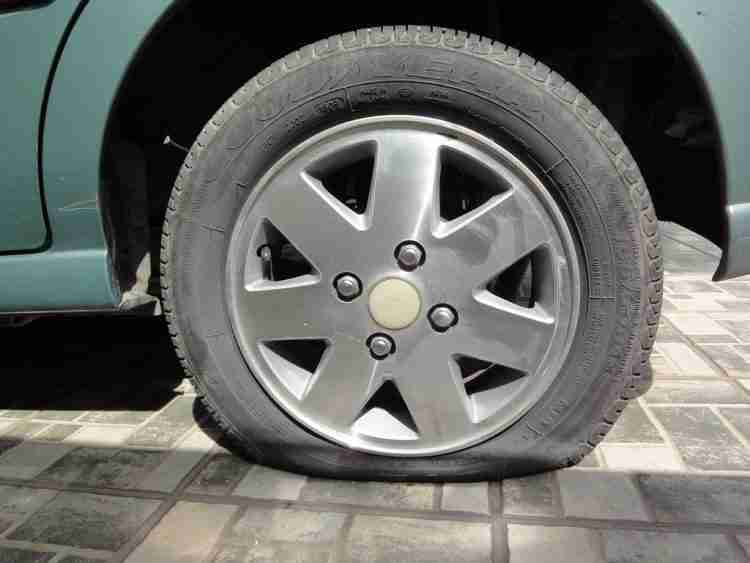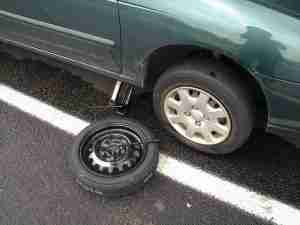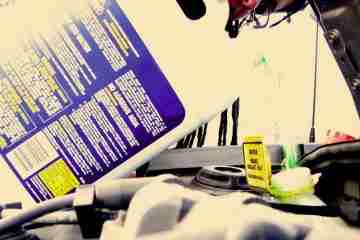Can I Drive With A Flat Tire?

Can I Drive With A Flat Tire?
Tires are susceptible to damage and are easily punctured by sharp objects, such as nails, on the road. But can you drive with a punctured or flat tire? Let’s find out.
Having a punctured tire is a real hassle, especially when you’re driving down the road. In addition, it can easily turn into a flat tire since there’s nothing to hold the air in place.
The first thing that almost all drivers think when they’re in such a situation is whether or not they can drive on a flat tire. Here, we’ll discuss whether it’s safe to drive a car with a punctured or flat tire and what you should do in such a situation. So, let’s get started.

You should immediately pull over if you experience a punctured or a flat tire while driving on the road. Not only can it necessitate expensive repairs by damaging your wheels, but it can also lead to a car accident or blowout.
So, it’s recommended to stop your car in a safe spot as soon as possible even if you experience only a slow puncture. It’s critical to have a set of tires in optimal working condition to ensure the safety of everyone on the road, including yourself.
It’s also important to note that driving for long distances with a flat tire is considered reckless and dangerous. In addition, driving with a known fault can also carry a penalty like a point on your driver’s license and fine.
It’s Not Just Your Tire That’s At Risk!
Driving with a puncture can greatly degrade the tire and in worse conditions, it can damage your vehicle’s internal components. Here’s why a punctured or flat tire can be seriously dangerous.
Damages The Tire Beyond Repair
If one of the tires doesn’t have enough air to support the weight of the vehicle, then it can damage the internal structure. The intensity of the heat increases inside the tire and it starts to disintegrate and can become damaged beyond repair.
Can Potentially Damage The Rim
Driving a car with a completely underinflated tire also means that it’s running on the rim. Not only can it bend the rim, but it can also set the tire on fire.
Puts Your Whole Car At Risk
You can put your whole car at risk by driving with a flat tire for a long period of time. It can separate the tire from the rim, putting the expensive car components, such as brake lines, calipers, fenders, wheels, and suspension parts, at risk.
Increases The Chances Of Losing Control
Driving on a punctured or flat tire also means that you can lose control and badly hurt yourself and everyone else involved. Damage to the suspension parts and brake lines can lead to unstable car behavior, which can cause a road accident.
What Should You Do If You Have A Punctured Or Flat Tire?
You’ll feel the tire going flat even if you don’t hear it while driving. It usually feels like you’re unable to accelerate your car and it’s being pulled to the flat tire’s side. In such a scenario, you should perform the following:
Pull Over Safely
First of all, it is critical to keep control of yourself and the car by remaining calm in such a situation. You’ll need to apply increasing pressure very gently rather than slamming on the brakes. It’ll allow you to maintain control of the car.
Get as close to the side of the road as possible, preferably on a shoulder with some additional room. You don’t want to get hit by passing cars, so consider giving yourself as much space as you possibly can. Set up safety cones behind your car if you have them to provide other people with an extra warning.
Put On The Spare Tire

No matter what you do, don’t drive your car with a punctured or a flat tire. Instead, replace it with a spare one. You can then go to a service center to get your punctured tire repaired.
If you don’t have a spare tire, then consider calling your local roadside assistance to deal with the situation.
What Causes A Flat Tire?
The following are the most common culprits that can cause a punctured or flat tire:
Penetrating Objects
Mostly, a flat tire is caused by sharp objects, such as screws, nails, industrial staples, and scissors, that are found on the road. These objects are made of strong metal and can pierce the tire tread easily when you drive over them.
Glass, on the other hand, can’t penetrate the tires because of the steel belt construction. However, it can chip the tire tread.
Slow Leaks
Sometimes the penetrating objects fall out of the tire and create a slow leak, decreasing the air pressure. It can also happen around the wheel’s edge. In such situations, it’s known as a bead leak.
It mostly happens because of the debris or corroded parts of the wheel that keep the tire from making an airtight seal.
How To Avoid A Punctured Or Flat Tire
Consider following the best practices mentioned below to mitigate the chances of getting a puncture or flat tire.
- According to the NHTSA (National Highway Traffic Safety Administration) recommendations, you should check the pressure in your tires at least once a month.
- Inspect your tires regularly.
- Avoid exceeding the load limit of your tires.
- Don’t drive your car on a road with potholes, and watch for road hazards.
- Use run-flat tires that allow you to drive your car for about 50 miles at 50 MPH or low speed.
The Bottom Line
Driving on a punctured or flat tire can be extremely dangerous, and it can hurt you and the people around you. It’s advisable to pull over immediately whenever you experience a punctured or flat tire and replace it with a spare one.
Flat tires are common, as it’s not possible to miss every single harmful object on the road. If you like to be prepared, then consider following the best practices mentioned above to avoid a flat tire.













No Comment